The World Health Organization has declared antimicrobial resistance, commonly known as AMR, as one of the top ten global public health threats facing humanity. Misuse and overuse of antimicrobials are the main drivers in the development of drug-resistant pathogens, according to the global health body.
India, a global pharma giant, has a huge problem of antimicrobial resistance and experts have been warning against it.
“India has a huge population and the antimicrobial resistance issue with India is quite prominent,” said Shaikh Z. Ahammad, Associate Professor at the Department of Biochemical Engineering and Biotechnology at Indian Institute of Technology, Delhi. He was speaking at a webinar organised today by Centre for Science and Environment (CSE). It was a part of the non-profit’s three-part webinar series to mark the World Antimicrobial Awareness Week that falls from November 18 to 24.
The webinar focused on the theme of ‘environmental and prevention agenda’ and how the world can ensure that waste from food systems, pharmaceutical and manufacturing, and human health systems is effectively managed to contain AMR, and on the importance of preventive approaches.
Also Read: India, a pharma super-power, must address the serious threat of antimicrobial resistance
Antimicrobials – including antibiotics, antivirals, antifungals, and antiparasitics – are medicines used to prevent and treat infections in humans, animals, and plants. Antimicrobial resistance occurs when bacteria, viruses, fungi, and parasites change over time and no longer respond to medicines making infections harder to treat and increasing the risk of disease spread, severe illness, and death. It threatens the effective prevention and treatment of an ever-increasing range of infections caused by bacteria, parasites, viruses, and fungi, warns theWorld Health Organization (WHO).
Overuse of drugs, sewage treatment plants and AMR
According to a note released by CSE, antimicrobial resistance accelerates due to the misuse and overuse of antimicrobials in human health, animal health, food-animal production, and crop production.
Additionally, the environment plays a significant role – waste from farms, factories, community, and healthcare settings contribute to the emergency and spread of AMR through environmental routes.
Talking about how the sewage treatment plants create pollution, specially in Delhi, instead of treating it and also aid in the problem of AMR, Sheikh said that the problem of antimicrobial resistance can create a double burden for the country since it is still fighting to manage commercial pollutants like sewage and is yet to create infrastructure do deal with it.
Also Read: Environment ministry quashes limits for discharge of antibiotic residue in water bodies
“Because of a huge population we use a lot of water for survival. Additionally, we generate almost 40 million liters of sewage everyday, apart from industrial water. Sewage is creating a significant impact on the environment. In a case study where we focused on Delhi, we found that while the sewage treatment plants do several good things for the environment, however with respect to AMR, most of the treatment plants work like a harbouring station. They increase the pollution rather than treating it,” he said.
AMR and agriculture
In his presentation, Ed Topp, Principal Research Scientist, Environmental Microbiology and Chemistry, Agriculture and Agri-Food Canada stated that large amounts of antibiotics are used for prevention, therapy, and in some jurisdictions growth promotion as well. AMR can be transmitted through food chains whereas waste streams can do so to the environment.
In many lower-income settings, households that reside in close proximity to animals may have concerns of direct exposure to AMR through those animals, Topp noted.
“Microbial use is contributing to AMR food production systems and in one health context, that is of concern both from environmental dimension and the health dimension,” Topp said.
Also Read: The growing menace of antibiotic pollution by pharma hubs needs urgent attention
He called for reducing antimicrobial use where possible through stewardship practices wherever alternatives make sense so that individual animals can be treated and not held in herds.
“A big challenge that we have in this sphere is source attribution, so clearly pointing the picture from food or environmental matrix into humans is a challenge,” he added.
AMR and waste from farms and factories
The three antimicrobial resistance determinants identified by Rajeshwari Sinha, programme manager at the Food Safety Programme of CSE, included antibiotic residues, resistant bacteria, antibiotic resistance genes that travel across multiple sectors. She also noted that the nature of waste and AMR determinants vary across sectors and local contexts.
Talking about the inter-sectorial transmission also takes place in AMR, she said “Waste from animal farms particularly poultry, dairy, fish as well as crop farms form a huge component of agriculture fertilizer and contribute to making the soil fertile for raising crops. At the same time, it’s used to feed fish, mushroom farming. Waste from dairy farms finds its way into useful components in agriculture. Thus, within each sector, there can be inter-sectoral happening which adds to the reservoir of AMR determinants.”
Also Read: Antimicrobial resistance could possibly become next public health crisis: Experts
It’s important to note that WHO had listed lack of clean water and sanitation and inadequate infection prevention and control promoted the spread of microbes, some of which can be resistant to antimicrobial treatment.
Sinha also noted that there was very limited on-the-ground progress – lack of dedicated funding within the overall limited funds for AMR, limited know-how and capacity due to absence of global guidance, complexity and cross-cutting nature of the issue. In her presentation, she also highlighted that the environmental AMR issue is so far dependent on surveillance which is resource-intensive and technically demanding.
A few of her recommendations included prioritising and investing in the environmental AMR agenda from both a global and national level and focusing on prevention at farms, biosecurity, clean water, alternatives, good animal husbandry practices, and vaccination.














